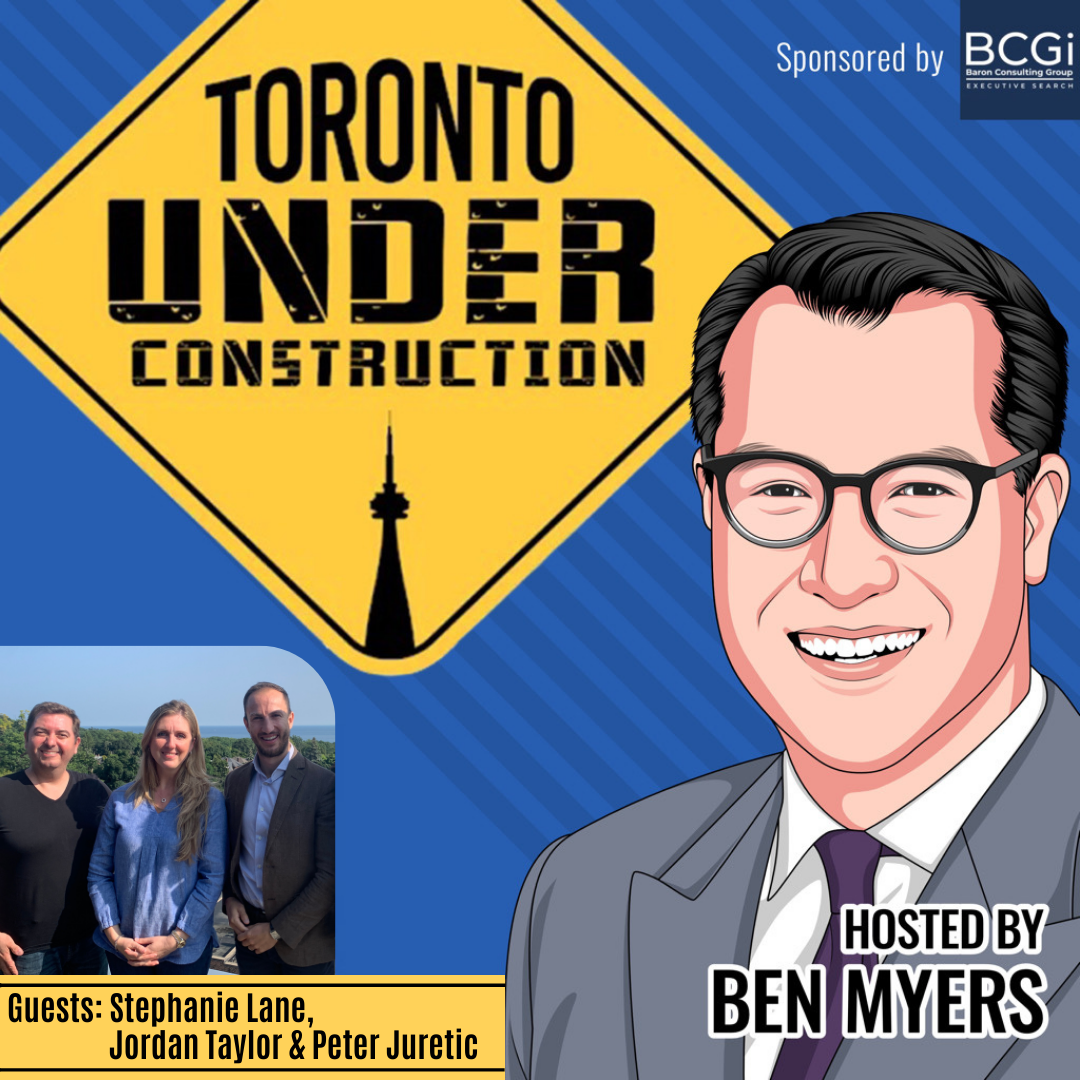This podcast is sponsored by BCGi Baron Consulting Group Executive Search -if you enjoy the show, please support our sponsors: BCGI Website

Toronto Under Construction Podcast: Low-Density Development Panel Discussion
In the latest episode of Toronto Under Construction, Ben is joined by Peter from Caliber Homes, Jordan from Deco Homes, and Stephanie from Geranium Homes to explore the dynamics of low-density developments in the Greater Toronto Area. Ben first asks each guest to introduce themselves and explain their role within their respective companies. Peter introduces himself at 1:51, followed by Jordan at 3:25, and finally Stephanie at 5:12, as they share their professional backgrounds and their firms’ roles in the real estate market.
Market Barriers: Insights from the BILD Media Release
Ben kicks off the conversation by referencing a media release from BILD titled “June new home sales in the GTA remained low – new projects facing structural barriers; high costs to build”. The release highlights that single-family home sales in June were 607, a 5% increase from June 2023, but still 38% below the 10-year average. Ongoing issues such as rising material costs, labor shortages, and lengthy approval times continue to delay new projects, making housing less affordable. BILD’s Senior VP Justin Sherwood emphasizes:
“Significant ongoing structural issues, notably the cost to build and lengthy approval timeframes, are hampering the ability for new projects to come to market – and limiting affordability,” said Justin Sherwood, SVP Communications & Stakeholder Relations at BILD. “We are continuing to see some sales return in select regions of the GTA, predominantly single-family homes and outside of the City of Toronto. However, the high costs of material, labour, and land combined with municipal fees (such as development charges) and slow municipal approvals are adding unnecessary costs and delays to new projects. This in turn is causing price stickiness and acting like a brake to new projects. ”
Ben turns to Stephanie asking how Geranium’s developments outside the GTA, such as in Kawartha Lake and Elora, are performing. Stephanie shares her thoughts on the market’s shift at 8:36. Jordan jumps in at 12:37, explaining why Deco Homes chose to launch their Castle Mile project in Brampton. Peter, at 12:58, discusses Caliber Homes’ strategy for managing their inventory of townhouses and stacked townhouses.
Supply vs. Demand: A Response to Ontario’s Housing Crisis
Ben shifts focus to an August 2024 article from the National Post titled As Ontario struggles to boost housing supply, the province should look to reduce demand – Construction is falling far short of the average of 150,000 homes a year required under Premier Doug Ford’s plan. The article emphasizes:
“Most of Ontario’s efforts to solve the housing crisis have focused on the supply side. The government has attempted to speed up housing approvals and boost the supply of construction workers. That’s useful, but it doesn’t matter much without buyers who can afford the product.
An adequate supply of housing is a high priority for Ford, but so far, it’s not working out despite his best efforts. Slowing population growth won’t solve all the province’s housing problems, but it will help. It’s certainly easier to achieve than a 50 per cent increase in the housing sector’s capacity.
Ford needs to make this point forcefully with the public and with his federal friends. Without a reduction in demand, his housing fix is never going to work.”
Ben asks Jordan whether Ontario’s issue lies in excess demand or insufficient supply and if Premier Ford should pivot his strategy toward reducing demand. Jordan provides insights into the supply-demand equation and potential solutions at 25:44.
Impact of Immigration on Low-Rise Housing Demand
Immigration continues to fuel demand for housing in the GTA, and Ben asks Stephanie whether new immigrants are purchasing low-rise homes immediately or if locals with high home equity dominate the market. Stephanie shares Geranium’s observations on buyer trends in the low-rise sector. Tune in at 35:58.
Caledon’s Fast-Tracked Housing Developments: Is Low-Density a Solution?
Ben brings up a March 2024 article from the Caledon Enterprise, which discussed Mayor Annette Groves’ use of “strong-mayor” powers to fast-track 35,000 new homes.
“Caledon is poised for transformation, and to ensure our competitiveness in the GTA, we must take bold steps to address the housing shortage,” said Mayor Annette Groves
Ben asks Peter whether Caliber supports the increase in supply or is concerned about competition driving prices down. Tune in for his response at 37:41.
Ben continues that Environmentalists, such as Phil Pothen from Environmental Defence, raised concerns, stating:
“Caledon may be wasting its opportunity to break with the failed, low-density form of development that has made it one of the most car-dependent and unaffordable parts of the Greater Toronto and Hamilton Area. This kind of wasteful cul-de-sac sprawl that seems slated for the intersection of Hurontario and Highway 410, for example, has no place in any 2024 zoning bylaw within the fastest-growing metropolitan area in all of Canada and the U.S.”
Jordan offers his thoughts on environmentalists’ concerns regarding low-density housing, responding at 39:19.
In that same article Pothen says that this “kind of wasteful cul-de-sac sprawl that seems slated for the intersection of Hurontario and Highway 410, for example, has no place in any 2024 zoning bylaw within the fastest-growing metropolitan area in all of Canada and the U.S,” Pothen said.
He also noted that the retention of minimum parking requirements, and aspects of the town’s communications about the new zoning, are cause for concern that a “walkable, transit supportive community is not actually planned.”
Stephanie adds her take on whether municipalities should focus on creating walkable, transit-oriented communities at 42:27.
The Growing Demand for Multi-Generational Living
Ben then moves the discussion to Kylemore Homes’ multi-generational living designs, which allow families to share living spaces under one roof. He reads:
“Kylemore’s WellGen Designs feature layouts that will enable families to be flexible with their choices and grow into the spaces provided. WellGen Designs focus Kylemore’s wellness approach on multi-generational living where grandparents, parents and children may choose to live together under one roof, sharing space, resources, responsibilities and experiences.
WellGen floorplans include self-contained 600-square foot coach homes, lofts, ground-floor bedrooms and suites, and private in-law suites, within a luxurious environment making it easy to live together comfortably. Sizes range from over 2,800 to over 6,000 square feet, with flexible spaces that can also be adapted to generate rental income if desired.”
He asks Jordan whether this concept aligns with Deco Homes’ vision and if they’re seeing demand for such housing. Tune in at 51:19. Stephanie follows talking about Geranium’s new ADU (Accessory Dwelling Units) plans in Belwood Estates and how they might appeal to buyers looking for flexibility and rental income opportunities. Tune in at 55:48.
Sustainable Design for 2024: How Developers Are Adapting
Ben references the Gensler Design Forecast: Mixed-Use Lifestyle Districts Bring Cities Back To Life from Storeys, which highlights that sustainability will become “non-negotiable” in 2024. The forecast emphasizes that cities encouraging a mix of retail, housing, and entertainment will better attract residents. The report points out that:
“Yet another byproduct of the COVID-19 pandemic is that monolithic office-focused downtowns are quickly becoming a thing of the past. What’s en vogue right now is vibrant, experience-driven social districts with a wide range of uses — retail, entertainment, sports, housing — that prioritize ease of access.
The traditional “central business district” is a concept that is losing its luster, and cities that encourage a mix of uses and make use of public-private partnerships will be able to better drive investment in those cities.
“By prioritizing safety and mobility in these new multi-modal districts, cities can attract residents and tourists and bring COVID-impacted neighbourhoods back to life.”
Ben asks Peter how Caliber is adapting to these trends and what shifts he’s seeing in buyer preferences. Tune in at 1:06:10.
Current Challenges in Real Estate Development
As the conversation progresses, Ben asks the group to share the challenges they’re currently facing. At 1:20:53, Peter discusses financial pressures and market uncertainty, while Stephanie follows at 1:28:24, sharing the difficulties in managing construction costs and approval timelines. Jordan joins the discussion sharing some challenges that he’s facing as well.
Rapid Fire Questions
To wrap up the episode, Ben transitions into his signature rapid-fire round, where he asks the guests a series of quick, fun questions. The guests answer questions like Who is easier to deal with, move-down empty-nesters, or first-time buyers? What percentage of your purchasers pay for a finished basement when buying a single-family home? Is it acceptable to take your shoes off on an airplane? What is more fun, being a real estate lender of a real estate developer? What’s more important to you customer satisfaction or construction quality? If the GTA gets a second NHL team, will the arena be in Mississauga, Vaughan or Markham? Are open-concept layouts still dominating floorplan design, or are there purchasers looking for more closed off and separate spaces? And Are skylights still a thing?
This episode provided a deep dive into the complexities of low-density developments in the GTA. With insights from three major industry players, listeners gain a clear understanding of the challenges and opportunities that lie ahead. Be sure to tune in to the full episode for more expert insights into the future of real estate development in the region.

Tune in now to episode 71 of the Toronto Under Construction podcast!
Follow Bullpen On Twitter@BullpenConsult
Interested in being a guest on our podcast? Send us an email.

